Pumpkins are a daunting prospect for new gardeners. It’s easy to think of them as difficult veggies, but they are actually quite simple, enjoyable crops to grow once you get started.
These huge globes of fleshy flavour, ready for baking, frying, or carving into whatever wonderful concoction you could possibly imagine are fun to grow, and last for months in storage, making a perfect presentation of that traditional term ‘the winter larder’.
To grow your own pumpkins, and grow them well, follow our in depth guide here, where we’ll lead you through everything from raising pumpkin seeds to maximising their storage potential.
Along the way, we’ll share tips on the best pumpkins to grow for flavour, as well as those that will just look incredible on a shelf!
More...
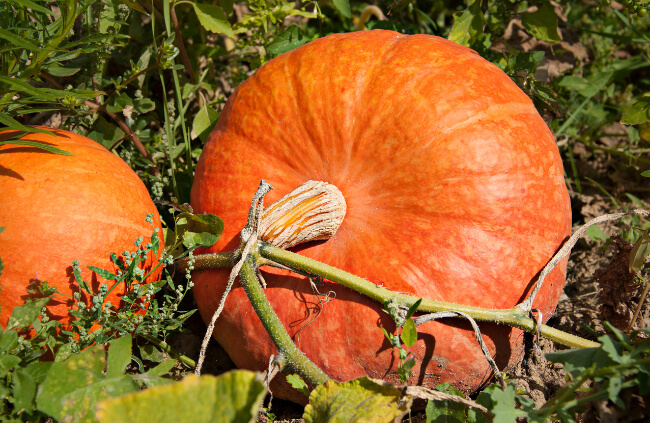
Family: | Cucurbitaceae |
|---|---|
Genus: | Cucurbita |
Species: | Various |
Origin: | North America |
Common Names: | Squash, pumpkin, gourd |
Location: | Outdoor |
Type: | Annual vegetable |
Growth: | 1-2 m long vines |
Sun requirements: | Full sun |
Foliage Colour: | Green |
Flower Colour: | Yellow |
Flowering: | Summer |
Edible Parts: | Edible fruits and seeds |
Maintenance level: | Medium-High |
Poisonous for pets: | Non-toxic to cats and dogs |
What are Pumpkins?
Pumpkins are a member of the cucumber genus, Cucurbita. They are distinct from cucumbers in many ways though, with their thicker skins and sturdier, long-lasting flesh being the most important traits as a crop. Pretty much the only similarities are in a vague resemblance in leaf shape, vine structure, and seed shape.
Grown on long, trailing vines, the fruits can (in exceptional circumstances) reach up to 1.5 m across, but are typically between 10-30 cm in size, depending on the variety, seasonal conditions, and growing medium.
All pumpkins are annual vegetables, but will usually grow back the following year from fruits left to decompose naturally in their beds, so can be used well as a permaculture crop both for food, and as a summer and autumn ground cover to prevent weeds from taking over.
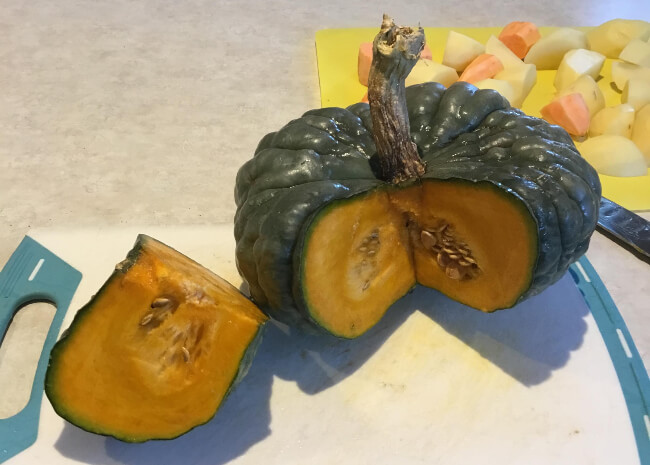
What’s the Difference Between a Pumpkin and a Squash?
Pumpkins and squashes are almost genetically identical, but there are some differences. In simple (but partly inaccurate) terms, pumpkins are winter crops, while most squashes are summer crops. However, there is a category of winter squashes that blurs the boundary.
I’m a keen squash grower, so find little joys in the subtle differences where I can. Perhaps the most important, particularly between winter squash and pumpkins, is that most winter squashes develop tendrils, allowing them to climb up trellis or chicken wire supports without tying in. Pumpkins nearly always lack those tendrils.
Basically, all pumpkins are squashes, but not all squashes are pumpkins. Like pelargoniums and geraniums, or violas and pansies, the wider classification doesn’t necessarily define the smaller group.
What is a Pumpkin’s Natural Habitat?
Pumpkins and squashes, strangely, evolved into what they are today in isolation from the rest of their genus. While cucumbers and gherkins are native to Europe and Asia, with the oldest records in India, Pumpkins are entirely isolated as a natural genus in the Americas.
Most pumpkins are so isolated in fact they are only found native in North America and northern Mexico. The stems are a clue to their evolution, and to the age of the species, as they use very basic moisture transfer and storage mechanisms inside incredibly hollow stems.
Their tendrils allow them to clamber through changeable shrubs and herbaceous plants to maximise their light exposure, but they grow equally well along the ground if they have enough light.
Essentially, you can grow pumpkins anywhere, and they will try their very best to produce some sort of fruit in order to reproduce. The trick, as we’ll discover, is how to grow the biggest and best pumpkins you can, in a climate they are in no way evolved to cope with.


Get Your Free Guide:
Master Growing Australian Natives eBook
A Must Have Complete Guide for Every Australian Garden
Get Your Free Guide:
Master Growing Australian Natives eBook
A Must Have Complete Guide for Every Australian Garden
How to Grow Pumpkins in Australia
Whether you’ve sown your own, or you’re working with seedlings from a garden centre, growing your own pumpkins is a really enjoyable craft. It’s a brilliant way to get your kids into gardening too, with competitions that are just as fun for you as they are for them.
Below, we’ll look at how to maximise yields, and make the most of your space when growing these space-hungry crops.

Where to Plant Pumpkins
Pumpkins need space and full sun. They are nutrient-hungry, space-hungry plants, often needing as much as two square metres per plant. Forget that at your own peril.
If you overcrowd pumpkins they will underperform. This is both a result of competition for nutrients, and because they are incredibly susceptible to common powdery mildew, a fungal problem caused by humidity, very often as a result of dense foliage when grown too close together.
Spacing Pumpkins
Large pumpkin varieties usually come on larger plants. Each seed packet will give a good indication of their spacing requirements, but as a general rule, big pumpkins and carving pumpkins need at least 1 m around each plant, while smaller types and early croppers are usually ok with 50-60 cm each.
Training Pumpkins Up Trellis or Supports
While pumpkins do not naturally climb, they adapt well to it. Training pumpkins by tying them to supports means that you can grow more in a smaller space, and that they will be better aerated – therefore reducing the chance of fungal infections like mildew.
When growing pumpkins up trellis, you should plant any variety around 40-50 cm apart, and as soon as they are tall enough, tie them to their supports (this can be chicken wire, trellis, bamboo canes, etc.). Tie them in once a week, or once every foot of growth.
See some of the best garden trellis ideas and kits here.
As fruits ripen, give them individual support by attaching old tights, or a hessian bag to the trellis to take its weight, as the vine will not be able to support large ripe pumpkins without some help.
Enrich your soil with extra manure every year around your supports by mulching after harvest. Or, for crop rotations, dig through a few inches of good compost before planting and feed regularly with extra tomato feed or liquid seaweed to provide balanced nutrients right through the season.
Growing Pumpkins in Raised beds & Borders
The easiest way to grow pumpkins, though not the most efficient, is to simply plant them into well prepared ground, with adequate spacing, and leave them to do their thing. Follow the basic guide for the soil, light, heat, and moisture requirements for pumpkins below.
Best Soil Conditions for Pumpkins
Pumpkins need rich soil. Many gardeners even use pumpkins as productive crops on semi-rotted piles of manure, which helps to lighten the potency of the manure, while making active use of the existing nutrients.
In terms of enriching your garden soil, or raised beds in preparation, you really can’t go wrong. Just add goodness, and keep adding it.
We usually add three inches of compost before digging it through, after harvesting spring crops, but if you have a dedicated pumpkin patch, add an even mulch of manure to the soil over winter while it’s empty. It will have rotted down and be usable with little to no digging the following spring.
Water and Moisture Requirements
Pumpkins are thirsty, but do suffer from excess humidity, so your soil does need to be reasonably well drained. Heavy clay is an absolute no-go for growing pumpkins, and boggy soils are bad too.
If the neck of your pumpkin plant is sat in water, it will rot, and you can lose an entire plant at any time of year as a result. Choose a reasonably well-drained site, and water it well, rather than relying on water-retentive compost.
How to Propagate Pumpkins
Pumpkin propagation is simple. Plant pumpkin seeds in late September, into warm soil, mounded to protect them from excess moisture, and water lightly until you see signs of germination.
In most parts of Australia that means there’s really quite a long growing season for pumpkins, so fruits can reach a good size by early autumn, or be left to develop thicker rinds by early winter.
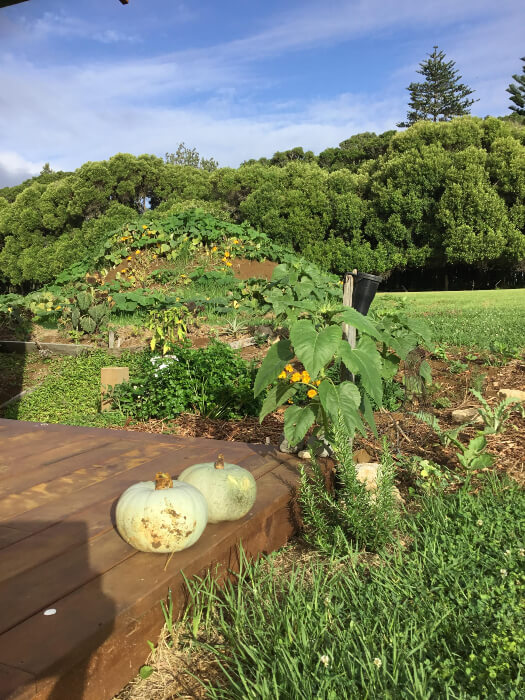
Pumpkin with the pumpkin vine growing on a dirt mound
Propagating Pumpkins from Seeds
Pumpkins are best sown directly in the ground (as above) where they are to grow. Like all members of the cucumber family, they do not like being moved or potted on, but it is possible.
In fact, we nearly always grow our pumpkins from seed in small pots, because by September, there are still a few overwintered veggies in the garden waiting for harvest, and it makes it easier to manage crop rotation that way.
- Start by filling a 10 cm pot with sieved garden compost (a 1 cm sieve is fine – or just remove large pieces and break them up).
- Sow two pumpkin seeds side by side, 2 cm deep (you can plant them on any angle other than flat side down).
- Water the pots well until the soil is completely soaked.
- Leave them somewhere bright and sunny with at least 6 hours of sunlight. Avoid night time temperatures below 12°C if possible.
- Germination can take up to two weeks, but is often faster.
- After germination, wait until seedlings are 5 cm tall. If both seeds germinated, remove the weaker seedling.
- Keep the soil moist but not soaked, and when daytime temperatures reach 16°C or more, move your pumpkin seedlings outside to harden them off.
When to Plant Out Your Pumpkins
When your pumpkin seedlings have four true leaves, and are developing their first buds, they are ready to plant out. The stems should be around 1-2 cm thick by this point, but the plants should be quite stubby.
The sooner you plant your pumpkins into enriched garden soil, the better, but either way, it’s important to pinch out these first few flowers to encourage new stems and foliage until you’re ready to plant them in their final position.
Note: They can reach this size within 3 weeks of sowing, or two months. As time goes on, you will need to feed seedlings in their starter pots to prevent nutrient deficiencies weakening the plants.
Caring for Pumpkins
Pumpkins aren’t hard to care for, but they can be time consuming. For example, they can develop a full covering of powdery mildew in under a week, but daily checks, and removing damaged leaves can stop the spread of infection in its tracks.
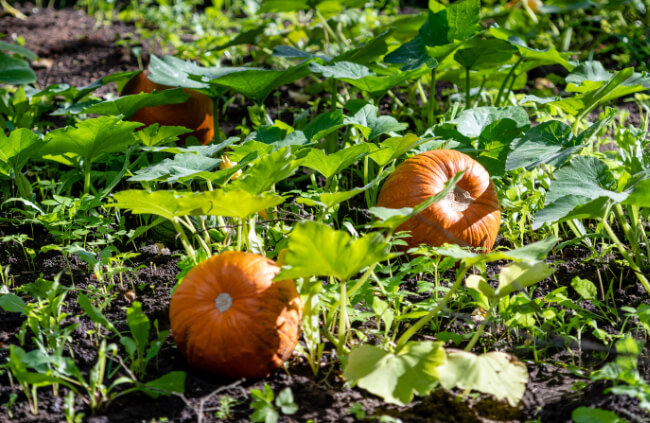
Pruning Needs
Pumpkins don’t need pruning, and usually grow much better without it. However, if you notice any discoloured, grey leaves, yellow spots, or powdery mildew coating a leaf, remove it using clean secateurs immediately.
If you don’t have one or in need of a replacement, check out our detailed guide for choosing the best secateurs in 2023.
If you choose to grow your pumpkins up a trellis (give golden nugget pumpkin a try), cut off the bottom two sets of leaves so you can water the soil without wetting them, reducing the chance of fungal problems.
When to Feed Pumpkins
It is possible to overfeed pumpkins, but it’s unlikely. We grow pumpkins here on manured soil, as well as beds with compost worked through. On both pumpkin patches we feed them a rich dilution of liquid seaweed once a week as soon as their first vine reaches 1 m long.
Harvesting Pumpkins
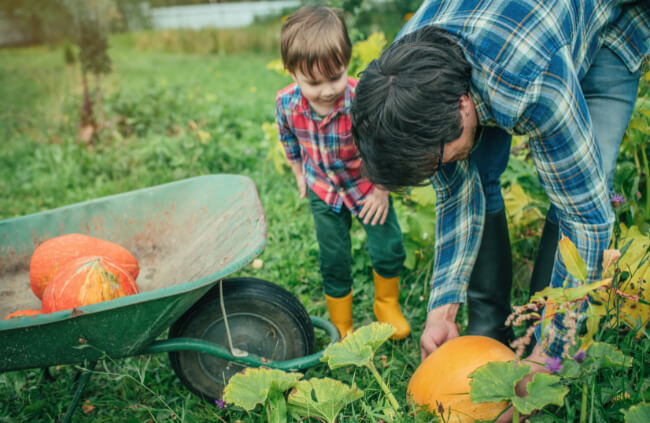
When are Pumpkins Ready for Harvest?
Pumpkins are ready to harvest as soon as their skins are hard to press, but are best harvested when they have completely darkened to their ripe colour.
Harvest pumpkins as soon as they’re ripe by cutting a T-shaped piece of stem with 2” either side of the connecting stem. This massively reduces the chances of infection while they cure.
How to Store Pumpkins?
To cure your pumpkins, leave them somewhere bright, well-ventilated and in direct sunlight for most of the day for around two weeks. This will help to harden their skins, and allows the stems to dry to a hard, woody texture, meaning infection can’t enter through the top.
After curing, pumpkins can be stored for up to a year, sometimes longer in any cool and dry spot.
Common Pumpkin Pests and Diseases
Pumpkins are highly susceptible to most garden pests, including slugs at every stage of growth, including the fruits themselves.
Protect trained pumpkins by placing jaggedly cut, bent, and shaped tubes of plastic (we use old 2l bottles) around their base when you plant them. Slightly bury the tube to create a surface that slugs can’t crawl over.
The most common disease is powdery mildew, which is most easily treated by removing the leaves. Protecting pumpkins from heavy rain during warm weather can also prevent mildew, but isn’t a practical option for most gardeners.
Pumpkin Frequently Asked Questions
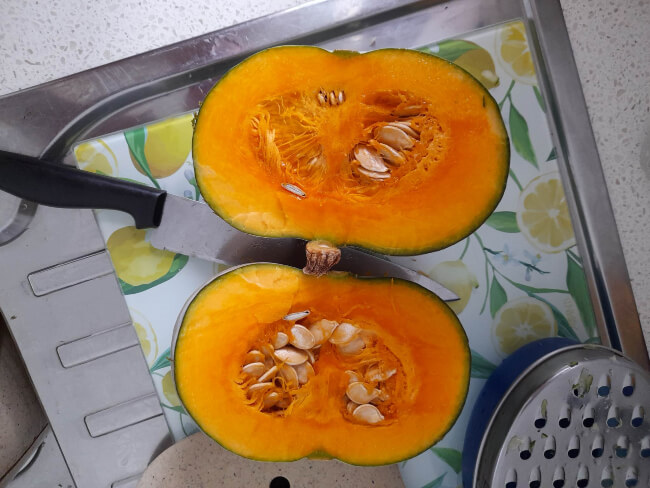
How long does it take for a pumpkin to grow?
Pumpkins take around 4 months to grow from seed to harvest, depending on the time of year they’re planted, and the variety. The only place you’ll have trouble growing them is Tasmania, but by planting just after the last frost there should be enough time to get a good crop.
How many pumpkins do you get per plant?
Each pumpkin plant can produce dozens of small pumpkins, but to get the most from each plant remove all flowers after the first two or three fruits have been pollinated, and continue removing new flowers to make sure energy is targeted on those fruits.
How do you know when a pumpkin is fully grown?
A pumpkin is fully grown when the stem begins to turn brown. At this point, the fruit is fully ripe and will not grow any further.
Can you eat a pumpkin straight after picking?
You can eat a pumpkin straight after picking, and roast the whole thing without even peeling it. Curing thickens the skin, which means your pumpkin will store for longer but for more flavour and faster eating, cook them straight off the plant.
Wrapping Up Our Pumpkin Growing Guide
Pumpkins are probably the most rewarding crop you can grow at home. If you grow a few plants, you’ll often have enough to last you for a full year, and those you grow at home will be cured properly and will store better too, as well as having more flavour.
Choose your pumpkin variety well, because the seed you sow has an impact on the flavour you get, and the success you’ll have. But, if you follow the steps in this guide, you’ll grow your own pumpkins with ease.
Published on August 5, 2023 by Maisie Blevins
Last Updated on September 20, 2025




